oberkarteufel
Harmless

Posts: 47
Registered: 11-12-2018
Member Is Offline
Mood: Mayonesium sulfate
|
|
Gold extraction attempt
So one day I decided I have too much money (yeeeeaaah, sure) and I bought some 14k (583) gold scrap, and decided to get the gold out.
Here I need to thank the kadriver/sreetips/bafelous for his very informative (even if long) YT films. They (with topics on goldrefiningforum) saved me
much time and effort.
Gold was inquarted with silver and melted in a furnace. Remember - mix it a graphite rod or something similar, or else your metals won't alloy
properly (own experience).
//Also, now I think that it would be better to use a torch rather than furnace - as soon as the crucible is taken out, it cools and some of the metal
sticks to the walls and can cause losses. Of course, you can later digest the crusible in HNO3 and then aqua regia, but it's easier to avoid metal
sticking to crucible walls, I think.//
The melted alloy was poured into metal can with water, and then digested in hot, dilute (ca. 20%) nitric acid. Acid was decanted, metal residue
treated again with hot nitric. Then again, cooled, decanted and washed two times with distilled water.
//This was also the moment I realized that my distilled water contains chlorides, crap. Nitric acid used earlier was diluted with 3% H2O2 to reduce
it's amount required for digestion.//
Then, the metal that turned meanwhile from silver to brownish colour was covered with conc. HCl and part of calculated conc. HNO3 amount was added.
Solution upon heating quickly turned yellow-orange, and brown gasses evolved. HNO3 was added carefully until all the gold dissolved and no metal
particles was visible; the solution was slightly turbid due to presence of white AgCl. Diluted the solution with water to decrease the AgCl
solubility. Reaction mixture was left to cool, AgCl sedimented. Filtered off the sediment, heated the clear solution to concentrate it by evaporation.
Added 1g of urea to reduce the HNO3 possible leftovers. Added excess of ascorbic acid, gold precipitated as dark, fine particles, solution turned dark
brown due to degradation of ascorbic acid. Mixture was left to cool, filtered and dried.
Prepared the porcelain dish //actually a wide crucible, but whatever// by glazing it with borax to prevent the gold from sticking to a porcelain. The
filter with gold precipitate was put into the dish, burned in a furnace and melted. While the borax was still melted, took out the gold drop with
metal tweezers. and put it into cold water. Scraped away the leftofers of borax, washed the gold drop, dried it and weighed.
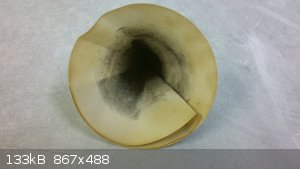 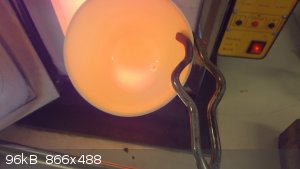 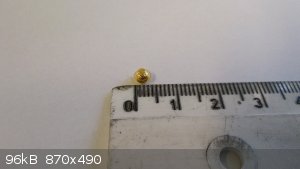 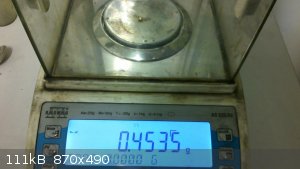
|
|
|
Sulaiman
International Hazard
    
Posts: 3558
Registered: 8-2-2015
Location: 3rd rock from the sun
Member Is Online
|
|
I find gold recovery addictive, electronics scrap and one used small 9 ct. gold chain kindly donated by a member on another forum.
https://www.youtube.com/watch?v=u_WO7DjMCks&feature=yout...
So far a grand total of 2.7g of gold dust 
- after maybe six or seven recovery batches and two re-refining runs 
A not-for-profit passtime. (time + cost of chemicals)
Did you weigh the gold before you started and calculate a yield ?
CAUTION : Hobby Chemist, not Professional or even Amateur
|
|
|
oberkarteufel
Harmless

Posts: 47
Registered: 11-12-2018
Member Is Offline
Mood: Mayonesium sulfate
|
|
Ha, that's a nice amount, indeed 
Non-profit maybe, but highly educational and verily addictive, I must admit 
Total initial amount was 1.96g of 583 gold, output of two batches is 1,139g. I estimate actual loss for ~10mg, however I located a tiny gold particle
stuck to crucible I used for final melting (the one in the photo above). I'm trying to recover the residue from crucible used for inquartation;
probably there hides the rest of my gold.
What is the average gold content in your e-scrap? What type of e-scrap was it? In mine (whole different story, I'll post it someday later) it was
about 25ppm.
And how fine your dust is? Something like in my pic or bigger?
|
|
|
diddi
National Hazard
   
Posts: 723
Registered: 23-9-2014
Location: Victoria, Australia
Member Is Offline
Mood: Fluorescent
|
|
e-watse metals recovery is definitely not profit making, but it is fun to try. when you have to pay retail for chems it is just not viable. maybe if
you get your acid in IBCs for next to nothing it would be worth looking into.
Beginning construction of periodic table display
|
|
|
Sulaiman
International Hazard
    
Posts: 3558
Registered: 8-2-2015
Location: 3rd rock from the sun
Member Is Online
|
|
The size and appearance of my gold dust
seems to be determined by the concentration of the chloroauric acid that I precipitate it from, using SMB.
This is when I had about 1g precipitated from a 'medium' concentrated solution
(I think about 0.2g Au per 1ml, but my memory is not reliable)
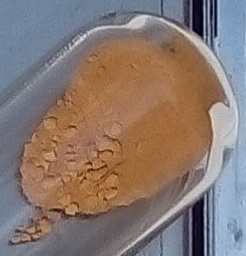
CAUTION : Hobby Chemist, not Professional or even Amateur
|
|
|
oberkarteufel
Harmless

Posts: 47
Registered: 11-12-2018
Member Is Offline
Mood: Mayonesium sulfate
|
|
@diddi - I know, and I did this only for fun, yyyyy educational purpose, of course 
@Sulaiman - I suspect that your particles are larger, as the colour is lighter. It may be, that ascorbic acid in given reaction conditions is a
stronger reducer than sodium metabisulfite. Faster reaction rate causes finer (and thus darker) metal particles.
Of course I know that ascorbic acid isn't best reducer for gold refining, as it's not selective.
|
|
|
Arthur Dent
National Hazard
   
Posts: 553
Registered: 22-10-2010
Member Is Offline
Mood: entropic
|
|
Next on my "to do" list. I have an ever growing jar of gold-plated e-junk, ready to be turned into precious stuff.
Always a bit problematic in an urban area, though. I have all the chemicals and hardware, but making a batch using Aqua Regia on my balcony is always
a bit hazardous. My best bet would be to make very small batches, collect the diluted Auric Chloride/Chloroauric acid and when I have enough,
precipitate it with Thio.
Might be a cool holiday break project.
--- Art is making something out of nothing and selling it. - Frank Zappa ---
|
|
|
Sulaiman
International Hazard
    
Posts: 3558
Registered: 8-2-2015
Location: 3rd rock from the sun
Member Is Online
|
|
To minimise the use of HNO3 and generation of NO2;
mechanically remove as much non gold bearing material as practical, e.g. by cutting away non-gold areas.
chemically remove as much non gold bearing stuff as practical by dissolving in (relatively cheap and available) dilute HCl,
time, patience, heat and mechanical agitation help
remove plastics, ceramics, pcb's etc.
thoroughly rinse off any HCl (or the next step will form Aqua Regia and you may loose some gold)
then use dilute HNO3 to dissolve most remaining non-precious metals, procedure as for HCl
NO2 will be released, but slowly enough to dissipate from a well ventilated area.
Do not use conc. HNO3 because you will get a lot of NO2 released quickly,
and you may passivate some surfaces.
by this phase the volume of material will be vastly reduced,
allowing minimal use of AR, heat and/or time help
use a minimum of HNO3 slowly added to excess HCl.
After filtration the gold can be dropped using your chosen reductant (e.g. SMB)
the dense gold will precipitate quicly allowing decantation then boiling to dryness,
rather than lossy filtering.
Now all you have to do is to deal with the waste 
Make or buy stannous chloride before you start so that you can be sure that no gold in solution is dumped.
CAUTION : Hobby Chemist, not Professional or even Amateur
|
|
|
Herr Haber
International Hazard
    
Posts: 1236
Registered: 29-1-2016
Member Is Offline
Mood: No Mood
|
|
Quote: Originally posted by Arthur Dent  |
Always a bit problematic in an urban area, though. I have all the chemicals and hardware, but making a batch using Aqua Regia on my balcony is always
a bit hazardous. |
You can remove most hazards by bubbling the NOx in water or NaOH solution.
I purchased a 3 liters reactor and a couple of wash bottles when one of my neighbours asked me if I wasnt worried I'd paint the building orange with
that "smoke"
Watch for suckbacks though if you do that.
The spirit of adventure was upon me. Having nitric acid and copper, I had only to learn what the words 'act upon' meant. - Ira Remsen
|
|
|